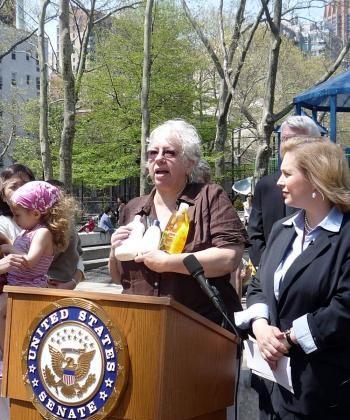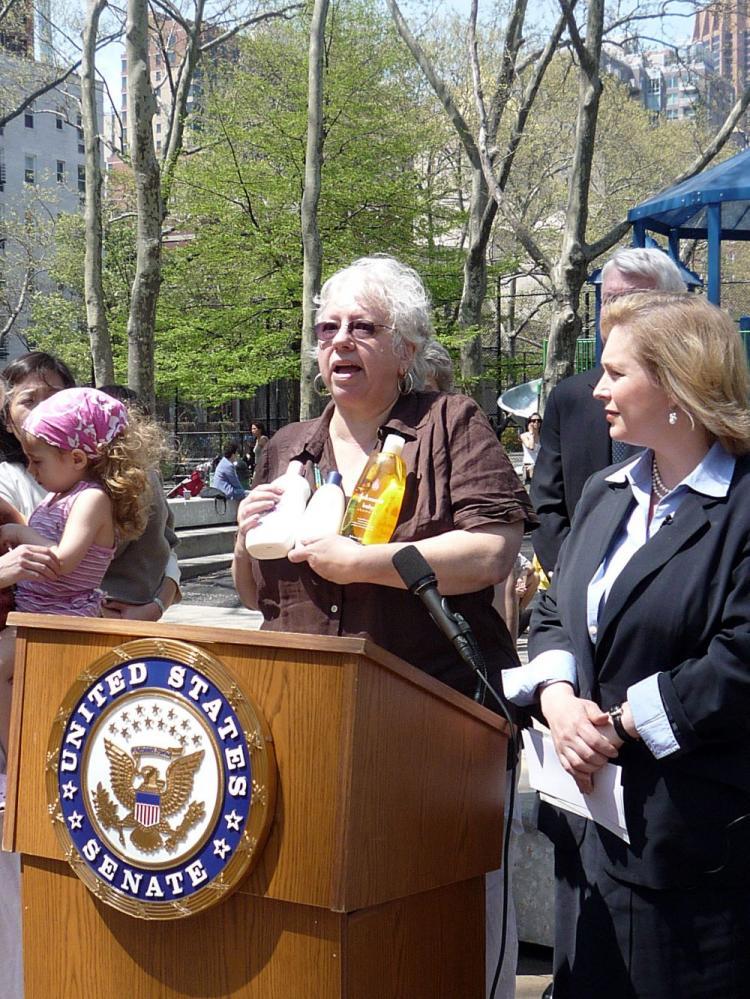NEW YORK—U.S. Senator Kirsten Gillibrand will be introducing a bill in the House this week to require that the FDA investigate the safety of ingredient byproducts in baby bath products. Currently, manufacturers are not expected to list those byproducts on the bottle, or to stop using the processes that lead to their presence in products.
The Campaign for Safe Cosmetics commissioned an independent laboratory to test 48 commonly used baby products for 1,4-dioxane and formaldehyde. The products tested include both generic and name brands of baby shampoo, bath wash, lotion, wipes, sunblock, and toothpaste. Of those, 67 percent contained levels of 1,4-dioxane, 82 percent contained levels of formaldehyde, and 61 percent contained both.
While formaldehyde is not put directly into the product, it may emerge with the eventual breakdown of preservative ingredients, according to Jane Houlihan of the Environmental Working Group. She and health and environmental advocates joined Gillibrand in announcing the proposed legislation.
The chemical 1,4-dioxane is used in the processes that make the product “gentler” for young skin and can be easily removed through a process called air-stripping. However, given little incentive, manufacturers often refuse to take the extra step.
Formaldehyde is an allergenic and carcinogenic preservative used in the embalming of dead animal tissue. The chemical 1,4-dioxane poses more risk inhaled than through dermal contact, according to research gathered by the CDC. In high concentrations, it causes kidney and liver alterations.
While exposure in the small amounts present in children’s bath products is unlikely to cause harm, report authors say, the long-term effect has not been well studied. Formaldehyde gas, for one, is emitted from pressed wood in furniture, cleaning products, and clothing, and is likely also contained in cosmetics marketed toward adults. Continued use of products containing formaldehyde may be linked to the increase in allergies and asthma incidences in recent years, says Houlihan.
Because of the lack of required labeling, the public can only assume that the products are safe. “Parents cannot shop around this problem,” Houlihan said. Often these products are recommended by physicians and pediatricians,” said Marian Feinberg from For a Better Bronx. She said that when she presented the report to her group, parents were shocked—one of the products that tested positive for 1,4-dioxane was recommended by doctors for children with eczema.
Expectations for the FDA
Gillibrand’s bill, the Safe Baby Products Act, would require the FDA to investigate the safety of baby products, publicly announce their findings, and create manufacturing guidelines to quell the presence of the toxins in them.
But for the FDA to look into the allegations would be a challenge. A report compiled by academics, industry, and governmental agencies said the FDA is able to check only a minuscule portion of imports and food manufacturers, and that its information technology is outdated. The FDA itself admitted as much last year. “It is no secret in Washington that as the FDA’s responsibilities have grown, the resources devoted to them have not kept pace,” said FDA food and drug commissioner Andrew von Eschenbach.
However, Gillibrand is confident that the government can come up with the resources to fund the investigation. “In the last administration, that was not the case, but now we know that [the current administration] will fund this initiative,” she said.
While the Obama administration has been busy tackling the economy during its first 100 days, the President has indicated that reform of the FDA and other food safety agencies is on his agenda.
The Campaign for Safe Cosmetics report, titled “No More Toxic Tub,” is available in full at http://www.safecosmetics.org.







